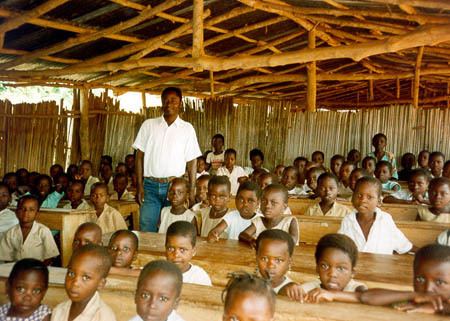 | ||
Although its education system used not to be free, Benin has now abolished school fees and is carrying out the recommendations of its 2007 Educational Forum. In 1996, the gross primary enrollment rate was 72.5 percent, and the net primary enrollment rate was 59.3 percent. A far greater percentage of boys are enrolled in school than girls: in 1996, the gross primary enrollment rate for boys was 88.4 percent as opposed to 55.7 percent for girls; the net primary enrollment rates were 71.6 percent for boys and 46.2 percent for girls. Primary school attendance rates were unavailable for Benin as of 2001. While enrollment rates indicate a level of commitment to education, they do not always reflect children's participation in school. Because of a rapid increase in the enrollment rate, the student/teacher ratio rose from 36:1 in 1990 to 53:1 in 1997. The overall adult literacy rate is nearly 40%. Only 25% of women in Benin are literate.
Contents
History
By the late 1980s, under Benin's Marxist government, the quality of education was seriously eroded and, by 1989, the education system was in a state of collapse. A key event in the reform of education in Benin was the national Conference on Education (Etats Généraux de l'Education-EGE) held in 1990 which adopted a national policy and strategy to improve education. Beginning in 1991, the government of Benin introduced significant changes within the Beninese education system.
Major advances have been made in education, especially in the areas of access and teaching/learning conditions. The gross enrollment rate has increased from a base of 49.7% in 1990 to 96% in 2004 and girls' enrollment from 36% in 1990 to 84% in 2004. Gender balance and geographic equity have shown significant improvements in gross numbers of girls and children from disadvantaged areas attending primary schools. Nonetheless, major constraints and challenges remain.
School system
The Republic of Benin operates on a 6-4-3-3-4 system:
Education is compulsory for children between ages six and eleven. After spending two to three years in kindergarten, it takes six years for them to complete and take the primary school certificate. Overall it requires seven years to complete both junior and senior high school. At the end of the four first years of junior high school, the students have to take the O-level (Brevet d’Etudes du Premier Cycle: BEPC). Then after three years the students have to take the A level (Baccalauréat: BAC) exam which is the equivalent of the U.S. high school diploma. There are five vocational schools, located in five of the twelve provinces: Atlantique littoral (City of Cotonou), Oueme Plateau (city of Porto-Novo), Zou Colline (city of Bohicon) Borgou (city of Parakou), Mono Couffo, Atakora, Donga and Alibori.
Grading system
The grading system is from 0 to 20, with 20 being the highest grade.
Languages of instruction
French, the official language of Benin, is generally the language of instruction.
Leading public high schools
High School of Application:
Higher education
The National University of Benin maintains ten branches:
Each branch is headed by a university president.
Some private higher institutions are also accredited by the Ministry of National Education. Altogether 94 higher institutions are accredited.
